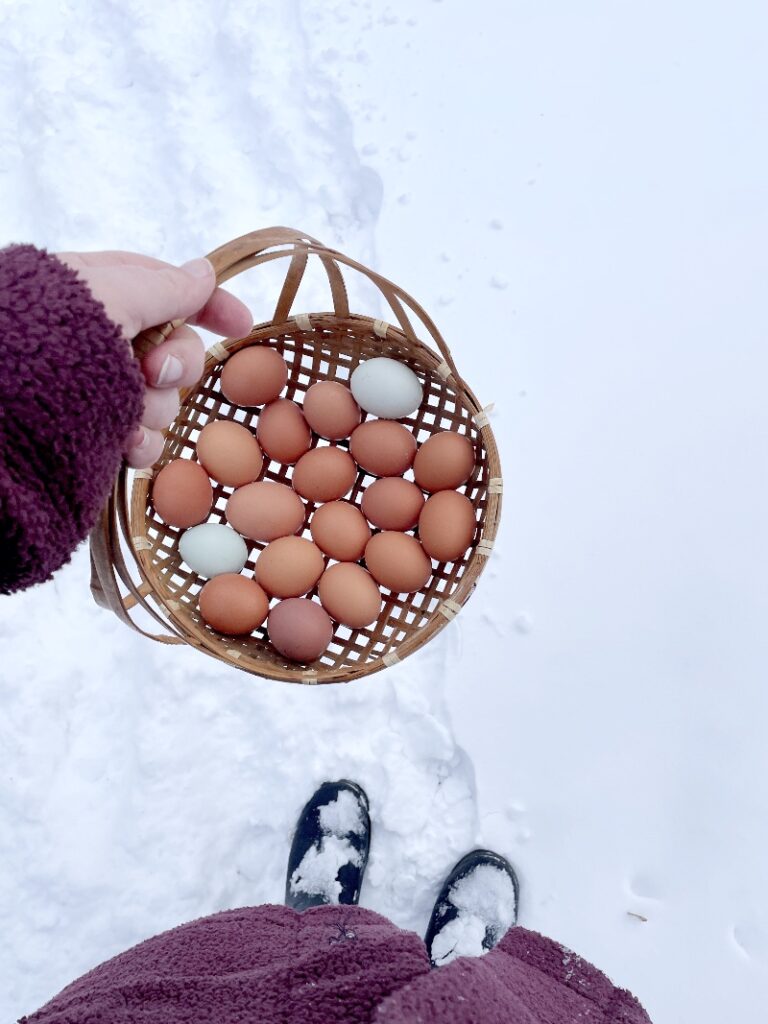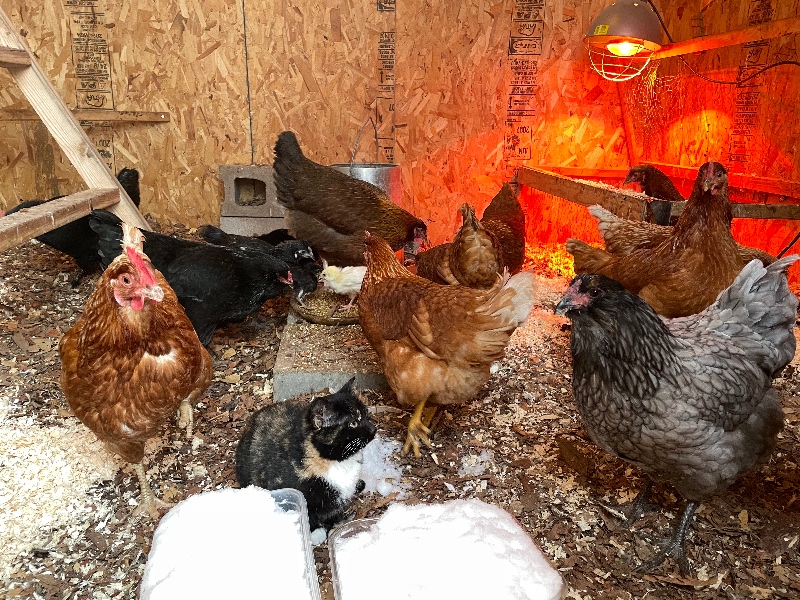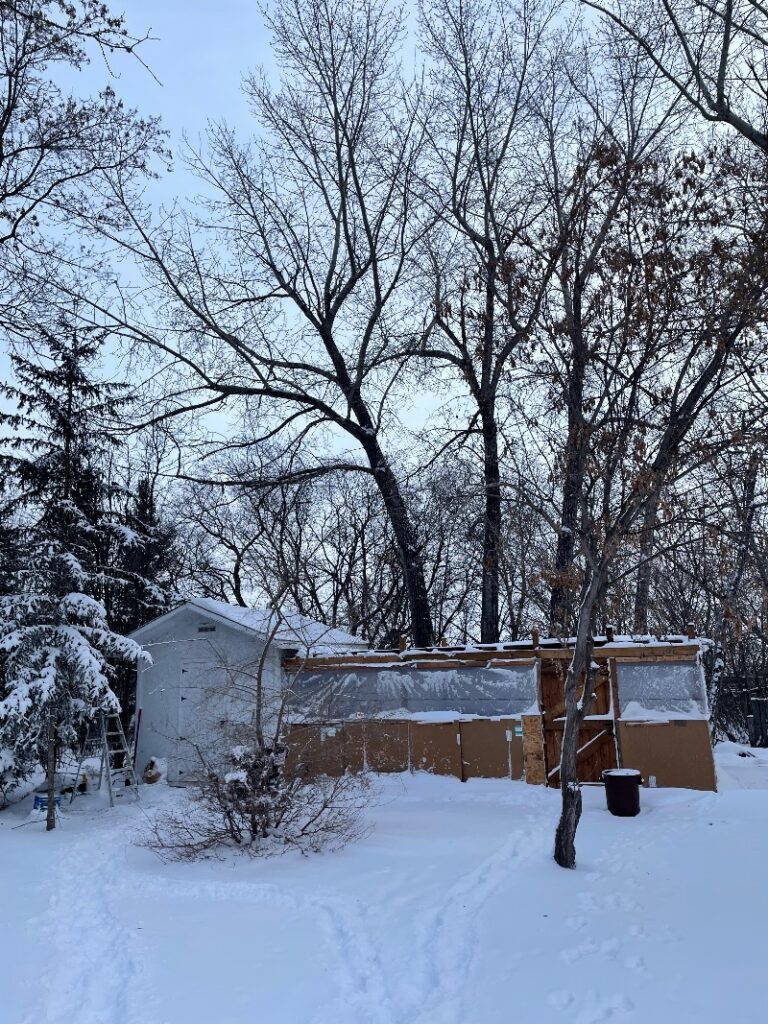This week we’ve been plunged into a Polar Vortex and our efforts to keep our chickens warm during the cold winter months with snow and extreme temperatures have been put to the test. Thankfully, the coop is staying warm and dry, and we are having very few issues with eggs freezing.
What’s more, we even have baby chicks that are around 3 weeks old, and they are thriving and even occasionally going outside into the run with their Mama Hen. In this post I’ll share what we’ve done, other options to keep your chickens warm, and the difference in temperatures from the outside to the inside of the coop.

As I am writing this, it is -28 degrees Celcius outside with a windchill of -37. When I went into the coop this morning it was -8 inside the coop, and that was after I had opened the door twice. All the eggs in the nesting boxes were good, and the only frozen egg was one that was laid by a naughty chicken right beside the opening to the run.
How We Keep Our Chickens Warm in Winter
Our strategy for keeping our chickens warm in extreme temperatures comes down to these 6 things:
- Having an insulated coop
- Using the deep litter method
- Having enough chickens for the size of our coop
- The run is covered in plastic and cardboard to keep the wind and snow out
- Using a heating lamp because we have baby chicks (optional if we did not have chicks)
- Only having hardy chicken breeds that can withstand cold temperatures
Now let’s chat about the specifics of each one. . .

1. Build an Insulated Coop
Our coop was originally a cat house and is a 12 ft. by 12 ft. insulated shed. It has two windows and electricity available to it if we use an extension cord. It is attached to a run and the chickens have a door with an automatic timer that opens onto the run.
If I were to build the shed over again, I would incorporate larger south-facing windows to let in as much heat as possible during the day in the winter months.
2. Use the Deep Litter Method
We love using the deep litter method and only clean out our coop around 3 times a year. To use, apply straw or wood shavings to your coop floor, in a deep layer, then keep adding more bedding every week, without cleaning out the coop. The heat from the chicken poop and the extra thermal mass of the bedding helps keep the coop warm.
This year I’m using dry leaves that I saved in bags during the fall, and plan to spread over my flower garden in the spring as a compost and layer of mulch. The chickens don’t seem to mind and using leaves keeps our cost for wood shavings down. We do use wood shavings in the nesting boxes.
3. Have Enough Chickens for the Size of Your Coop.
This was the big mistake we made last year, as we had only 3 chickens and it was way too big of a space for them. Unfortunately, they ended up getting frostbite, and struggled because I didn’t know that you also need grit for them in the winter months because they can’t forage around outside for it.
Allow 4 square feet for each chicken. Therefore, in a 12 x 12 coop we can safely have up to 36 chickens. We currently have 14 full sized chickens, 1 teenager, and 3 chicks, and they are keeping warm and doing well in the space.
However, don’t think that more is more and cram extra chickens in. If you have too many chickens, they will start to fight with each other and you will have wounded chickens on your hands. The pecking order is real, and not good if you’re at the bottom of it.
4. Protect the Run from Wind and Snow
Chickens are surprisingly hardy birds, especially if they are protected from the wind and snow. We cover our run with plastic on top and cardboard on the bottom, although just plastic works as well. By using clear plastic you also get a greenhouse effect, which further warms up your coop!

5. Use Extra Heating if You Have Chicks that Are Not Fully Feathered
We had no intention of having Christmas chicks, but because of the unseasonably warm November we had, one of our hens went broody and I wanted to see if chicks in the winter were actually feasible. I have been surprised how hardy the chicks are and they even come out into the run for a bit everyday.
We use a heat lamp over by the brooder area so that they have a space to warm up, especially if their Mama Hen is taking a break from them. I find that occasionally some of the other chickens will pop over there for a little while if they’re cold, and then go back to the main area again.
Heat lamps are fire hazards, so if you are going to use one, make sure that it is as secure as possible. Heat plates are a much safer option
6. Only Choose Cold Hardy Chicken Breeds
Not all chickens are cut out to handle the cold. When sourcing your chicks, make sure that they are cold-tolerant breeds. Some breeds include Brahma, Austrolorpe, Dominique, Ameraucana, and many more. If you’re sourcing your birds from local chicken keeping groups, neighbours, or a local hatchery, you’ll get breeds that can handle the conditions in your area. If you decide to get eggs from farther away, make sure the place you’re getting them from has similar weather conditions.
For those of you who live in more temperate climates, this will not be as much of an issue, but for those of us who live in places where winter temperatures can drop between -30 to -40 degrees Celcius. You need a warm coop and chicken breeds that can handle those conditions.
Beware of Humidity
While the cold is concerning, most cold hardy chickens will make it through the winter as long as the coop is warm and dry. Frostbite typically starts to happen when there is too much humidity in the coop.
Some chicken keepers will move all food and water into the run over winter to keep the humidity down. You’ll also need to ensure there is some ventilation in the coop–a cracked open window will do if you don’t have anything else.
Is there anything else you do to keep your chicken coop warm in the winter? Let me know in the comments.

